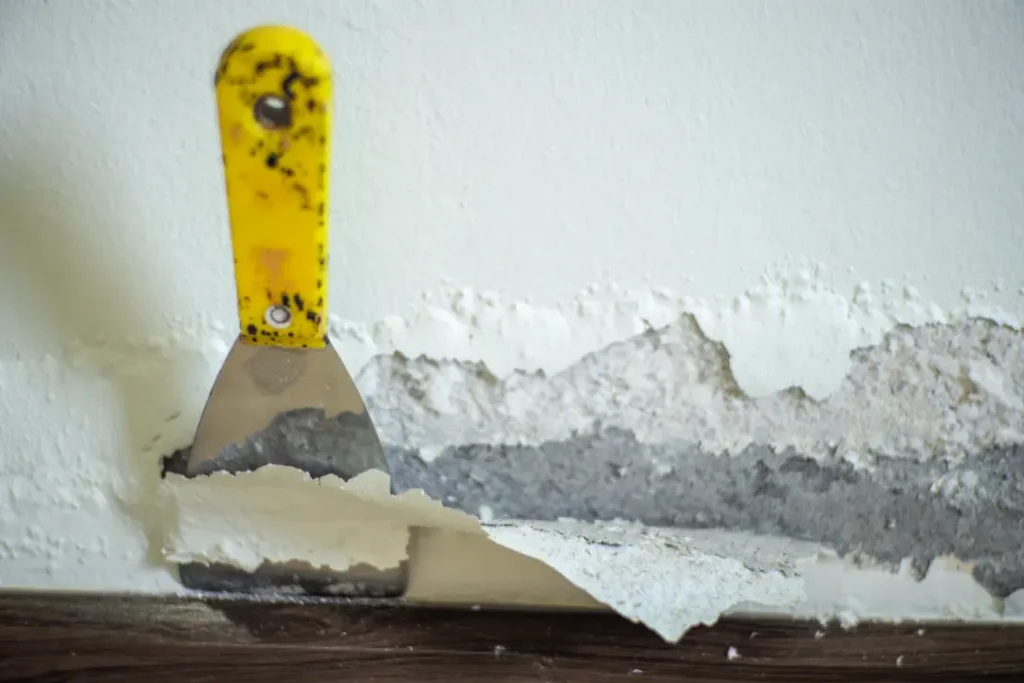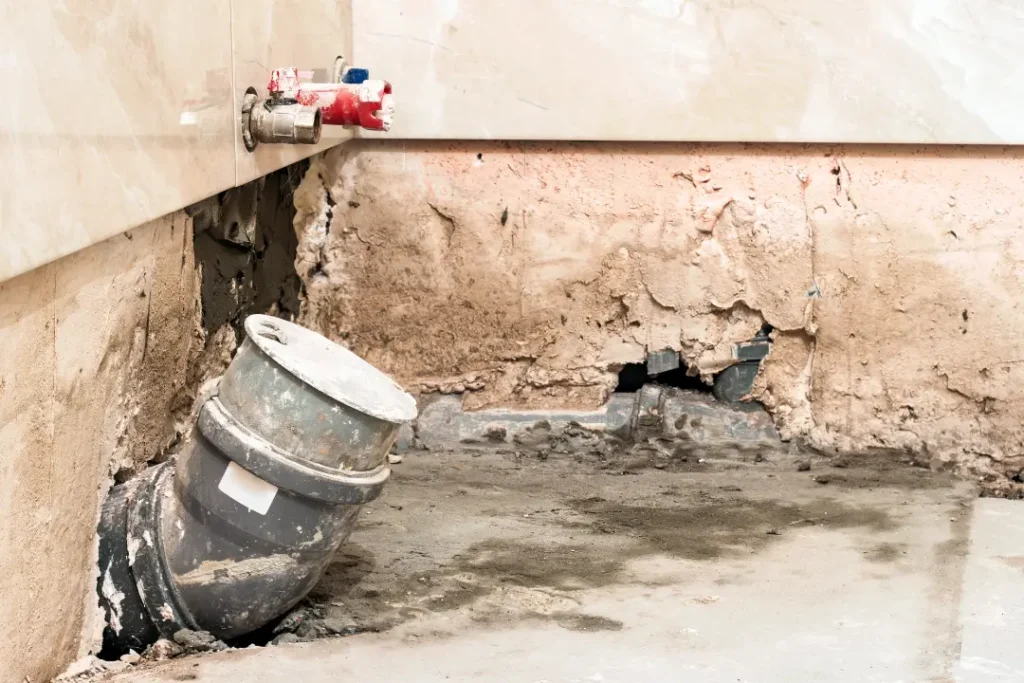Can I get insurance coverage for damp proofing repairs? Many homeowners hope their policy will cover these costs. This guide will help you understand if your insurance includes damp proofing and what steps to take.
Key Takeaways
- Damp proofing is essential for preventing moisture ingress and protecting property from rising damp, particularly in older buildings.
- Home insurance may cover damp-related damage only if it results from sudden incidents. It typically does not cover the costs of damp proofing measures due to expected regular maintenance by homeowners.
- Timely documentation and prompt reporting of damp issues are crucial for successful insurance claims, supported by professional damp surveys to substantiate the extent of damages.
What is Damp Proofing?
Damp proofing serves as a defensive strategy to shield structures from the encroachment of moisture and the ascent of rising damp. Older buildings often face challenges with rising damp, which stems from ground moisture ascending through internal or external walls due to an absence or failure of a damp proof course or membrane, heightened soil levels surrounding the property, or poor drainage systems. The application of a dedicated damp proof treatment can bolster defences against such moisture ingress. A professional damp survey is vital for early identifying signs of rising damp and related issues, allowing for effective management.
Property owners bear the responsibility of preventing damp issues by regularly maintaining their buildings. Neglecting this duty can lead to excessive humidity inside the structure, resulting in serious problems such as mould growth and potential structural damage.
Properties must have either an intact physical damp proof membrane (DPM) or an effective damp proof course (DPC) to prevent outside moisture from infiltrating. This helps keep both the internal and external walls dry and free from persistent damp conditions. If existing damp-proof measures are missing or inadequately installed, various issues can arise, including penetrating damp and typical cases associated with rising damp.

Types of Damp Proofing Methods
Various strategies exist to address rising damp and associated moisture issues, each tailored for specific situations and offering unique advantages. A prevalent approach is the placement of a damp-proof membrane beneath flooring surfaces as an impervious shield against humidity. These membranes consist of durable, pliable polyethylene sheets situated under floors to block the entry of moisture.
Injection techniques are another widespread method for infusing walls with damp-proofing substances. For example, where a damaged or absent damp proof course exists, it can be rectified by injecting a specially formulated damp proof cream into strategically drilled holes within the masonry. This newly created barrier effectively stops ascending moisture in its tracks within wall structures.
Given that older constructions often lack sufficient measures against moisture ingress, they stand at a higher risk of experiencing problems related to rising damp. By implementing these modern-day solutions for damping-proofing residences, property owners are able to take preventive action against water damage, which helps preserve both their homes’ longevity and structural soundness.
Is Damp Proofing Covered by Home Insurance?
Insurance policies for homes often include protection against various kinds of harm, among which are issues pertaining to dampness. Comprehending the extent of this coverage can be complex. If damage caused by damp arises abruptly due to events like pipes bursting or extreme weather conditions, then insurance may cover it. Conversely, should your home suffer from damp problems gradually over time because of inadequate upkeep or wear and tear, you may find that your insurance provider will not pay out.
It’s critical to grasp that while certain damages linked with damp could be insured under your policy, significant restrictions and caveats typically exist. It is commonly anticipated that homeowners undertake routine property maintenance. Expenses related to repairs for damp proofing might not be claimable on home insurance policies. Being aware of how your insurance addresses these matters can prevent considerable inconvenience and financial burden in future situations.
Investigating the particular circumstances in which damage from damp is insurable—including understanding prevalent exceptions and limitations—is recommended for all policyholders so as to ensure clarity about what protections their coverage truly offers.

What is the Coverage for Damp-Related Damage?
Home insurance policies may provide assistance for damages related to damp. For example, if mould caused by dampness suddenly appears following an incident such as a leak or burst pipe, it might be covered.
Nevertheless, if mould and problems associated with dampness are not reported or resolved quickly enough, insurers may deem them as deterioration due to wear and tear. This interpretation often leads to the denial of claims and underscores the necessity of addressing issues without delay. Rising damp is capable of inflicting aesthetic damage on walls alongside more serious impacts like brickwork compromise or decay within timber floor joists.
Therefore, in order to prevent moisture from seeping in—essential in effective damping proofing—you must remain alert and swiftly inform your home insurance provider regarding any arising concerns about dampness within your property. Such vigilance ensures a smoother process when filing claims.
Exclusions and Limitations
The majority of home insurance policies exclude coverage for the fitting or fixing of measures against rising damp. Building insurance commonly regards rising damp as a form of gradual deterioration, which falls outside the scope of protection offered. Hence, it is imperative to scrutinise your policy documents carefully to verify what aspects, if any, pertaining to repairs for damp proofing are covered before proceeding with a claim.
How to Make an Insurance Claim for Damp Proofing Repairs
In the process of filing an insurance claim for repairs related to damp proofing, meticulous record-keeping is essential.

Alt Tag: Making an Insurance Claim for Damp Proofing Repairs
Steps to File a Claim
When initiating an insurance claim for repairs related to damp proofing, it is critical to compile a detailed record of the damp problems. This includes taking photographs and creating comprehensive documentation to reinforce your claim. It’s important to promptly inform your insurer of any issues with damp in order to mitigate potential obstacles throughout the claims procedure.
To prevent having your claim denied because of postponements, report any issues with moisture without delay. Maintaining openness by swiftly communicating with your insurer regarding any concerns you encounter with damp can help avoid denials of coverage and guarantee you receive the protection promised under your policy.
Working with Surveyors
A damp survey conducted by an independent specialist can be instrumental in validating your insurance claim, as it meticulously documents the severity of the damp damage. Conducting such a survey prior to filing your claim is crucial for identifying both the extent of harm caused and its root causes. These professionals deliver thorough reports that bolster your case when presenting it to insurers.
Employing independent experts in damp surveys ensures they accurately identify what has led to and how extensive the problems are, offering vital proof for insurance claims. The precise and detailed data provided by these specialists play a critical role in enhancing the likelihood of success for your insurance claim regarding issues with damp.
At Environ Property Services, we provide expert damp surveys in London, helping homeowners like you and businesses detect, assess, and document damp-related problems with precision. Our professional surveys ensure you receive accurate reports that can be used for insurance claims, property purchases, or remedial work planning.
Preventive Measures and Their Impact on Insurance Premiums
By taking preventive steps, you can markedly decrease your insurance costs due to a diminished likelihood of claims. Insurers value the lower risk presented by properties that are kept in good repair and often offer reduced premiums to homeowners who proactively maintain their homes.
Benefits of Regular Maintenance
Regular maintenance of a property helps prevent small problems from becoming major ones, which in turn reduces the likelihood of expensive repairs. By keeping up with routine care, not only is the longevity of the property increased, but also significant damp-related issues that could lead to higher insurance premiums are lessened.
If the soil surrounding a building is not graded correctly, it can negatively impact the effectiveness of damp-proofing systems. Properly addressing such issues ensures that these damp-proofing solutions continue to function properly and prevent extensive and costly damage repair in the future.
Reporting Issues Early
Should you detect indications of damp within your residence, promptly determining the variety of damp present is essential. Immediate measures should be taken to rectify the problem. It’s critical to swiftly report any problems related to dampness to your insurance provider because postponements might lead to claim denials.
Neglecting early reporting of issues pertaining to dampness can cause insurance claims to be declined on account of inaction within a timely manner. Speedy communication emphasises the importance of confronting problems associated with damp at their onset in order not only to address them but also to safeguard your entitlements under your insurance policy.
Environ Property Services: Your Partner in Damp Proofing
Environ Property Services addresses damp-related problems using sophisticated methods and skilled personnel to deliver impactful resolutions. Our expertise in extensive damp proofing specialists is drawn from years of effectively combating such issues.
If you require a detailed damp survey or specific interventions for rising damp and other types of damp issues, Environ Property Services provides customised strategies suited to your property’s unique requirements. Our expert team works meticulously to safeguard your home against the detrimental effects of moisture intrusion.
Expertise in Heritage Building Restoration
At Environ Property Services, we are dedicated to the conservation of historic structures, combining contemporary damp-proofing practices with the preservation of their original essence. By integrating age-old restoration procedures and cutting-edge approaches to damp proofing, we uphold standards set for safeguarding heritage sites.
We employ sophisticated damp-proofing techniques that honour and protect the distinctive features of historical buildings. This not only retains their aesthetic appeal but also safeguards their structural integrity.
Summary
Implementing damp proofing is a crucial step in protecting your property from the harmful effects of moisture. While home insurance may cover some types of damage caused by dampness, it is important to understand there are significant limitations and exclusions in these policies. Taking preventive measures and regularly maintaining your property not only safeguards your home but can also result in lower insurance premiums.
Working with experienced professionals like Environ Property Services provides excellent protection against damp-related issues in your home. Our comprehensive range of solutions, along with our expertise in restoring heritage buildings, makes us the ideal choice for preserving the integrity of your property.
Frequently Asked Questions
Does damp proofing come with a guarantee?
Damp proofing typically comes with a guarantee, often for a period of 20 years, depending on the specialist.
Will my insurance cover damp proofing for rising damp?
Insurance rarely covers damp proofing, as damp problems generally fall under maintenance. Rising damp covered by insurance is uncommon unless caused by a sudden event, like a burst pipe. Issues with cavity wall construction or damp walls on internal or external walls are usually excluded. Check your policy for details.
What is damp proofing, and why is it important?
Damp proofing is essential for protecting buildings from moisture and rising dampness, which helps maintain the structure’s integrity and prevent mould growth and other damage.
Implementing this preventative measure is vital for the longevity of your property.
Are damp proofing repairs covered by home insurance?
Home insurance usually does not include coverage for repairs related to damp proofing if the issue arises from gradual deterioration or is due to insufficient maintenance.
Instead, home insurance policies tend to cover damage that occurs as a result of unexpected events, like pipes bursting.
How can preventive measures impact my insurance company premiums?
By taking preventive actions to decrease the likelihood of claims, you can reduce your insurance costs, since insurers recognise that properties that are well looked after present a lower risk.
Putting money into preventative strategies is advantageous not only for ensuring safety, but also for economic savings.

